In April, Peter Gardner bought a blighted house at 2335 Conti St. from the New Orleans Redevelopment Authority.* He was given a year to renovate the small house in Mid-City, so he stabilized it and started to work on financing and architectural plans.
Monday morning, he drove up and was shocked to see that the building was gone — demolished earlier that day by a city contractor.
Gardner frequently buys and fixes up run-down properties. He paid $30,000 for this property, located less than a block away from the abandoned railroad that is supposed to become the Lafitte Greenway, and just a few blocks away from the massive hospital complex now under construction.

Not only has his investment been gutted, he’ll probably have to pay thousands more for the demolition.
City spokesman Tyler Gamble defended the demolition Thursday, saying Gardner was required to start maintaining the property after he bought it April 24 and that the city didn’t know he was working on it because he hadn’t gotten the necessary permits.
The incident is reminiscent of the immediate post-Katrina era, when Mayor Ray Nagin’s administration demolished many buildings — some of which had been issued building permits — in an effort to rid the city of vacant, flood-damaged homes.
After Hurricane Gustav, Nagin issued an executive order allowing for demolitions in historic districts without review. In one case, the city tore down a house in Gentilly shortly after a couple bought it and started to fix it up. A church in eastern New Orleans won $300,000 in a civil rights suit after its building was demolished.
Earlier this month, the wrong house was demolished in Fort Worth, Texas.
The property on Conti Street was labeled as blighted as early as 2006, and again in 2009 when it was owned by the Redevelopment Authority. The city cited it for code-enforcement violations as recently as February.
On July 2, the city declared the building in “Imminent Danger of Collapse.” Gardner said it was no more in danger of collapse than it had been in the past, and he had propped up parts of the house that were sagging.
Tyler Gamble said in an email that Gardner should have gotten a permit to stabilize the property, but he didn’t.
“Despite the owner’s claim to have stabilized the property, the Code Enforcement inspection showed the work was insufficient,” Gamble wrote. “Had the owner attempted to stabilize the property and obtain the proper permits, the City would have known he was working on solving the problem so we didn’t have to.”
The city issued a demolition permit on July 16. Gardner said he wants to know why the city didn’t notify him or at least post a notice on the house warning that the city was set to be torn down.
The city is not required to notify the owner if a house is judged to be in danger of collapsing, Gamble said. “It was clear the property was a danger.”
Since Monday, Gardner said he’s tried to reach people in the city’s Safety and Permits department to find out what happened, but he hasn’t heard back. On Thursday, he met with Redevelopment Authority officials. Gamble said they discussed the purchase agreement and the agency’s policies.
Fox 8 News story
*Correction: This story originally said the property was sold in June; it was sold in April. (August 1, 2013)
This story was updated after publication to include comments from the city and recent photos of the property.


